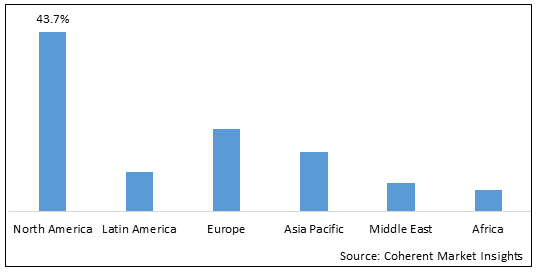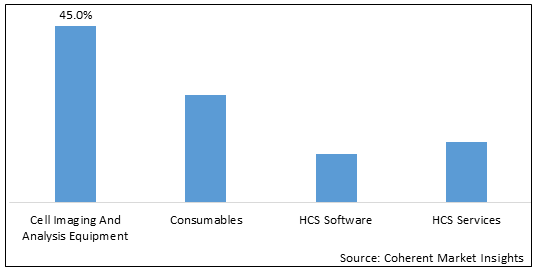High Content Screening Market is estimated to be valued at USD 2,067.4 Mn in 2025 and is expected to reach USD 3,067.8 Mn in 2032, exhibiting a compound annual growth rate (CAGR) of 5.8% from 2025 to 2032.
Analysts’ Views on Global High Content Screening Market:
Increasing research and development activities is expected to drive the market growth over the forecast period. High Content Screening can answer biological questions in the pharmaceutical industry and academia. In vitro toxicology including developmental toxicity, genotoxicity, developmental neurotoxicity/neurotoxicity, hepatotoxicity, cardiotoxicity, and nephrotoxicity utilizes HCS techniques. Several newly developed cellular assay models including induced pluripotent stem cells (iPSCs), three-dimensional (3D) cell models, and tissues-on-a-chip techniques are made possible. Genome editing technologies (e.g., CRISPR/Cas9), data analyzing tools for imaging, and coupling with high-content assays also make use of HCS. These approaches offer a huge step forward in dissecting biological processes, developing drugs, and making toxicology studies easier.
Figure 1. Global High Content Screening Market Value (US$ Million), By Region, 2025

To learn more about this report, Download Free Sample
Global High Content Screening Market – Driver
R&D in drug discovery is expected to propel growth of the global high content screening (HCS) market over the forecast period. For instance, in February 2020, researchers from Purdue University, a public land-grant research university, reported assessment of the effects of IL-27 – a heterodimeric cytokine composed of subunits IL-27p28 and EBI3 (Epstein–Barr virus-induced gene 3) – on the gene expression changes of TC2R prostate adenocarcinoma cells. HCS was used to identify RNAi (RNA interference) that cut down messenger RNAs that code those specific proteins which caused changes on the gene expression changes of TC2R prostate adenocarcinoma cells.
Moreover, increasing investment in HCS is expected to aid in growth of the market. For instance, in January 2020, St. Jude Children’s Research Hospital invested US$ 13.4 million for building a laboratory resource center, which will include two new labs, the Center for Modeling Human Pediatric Diseases and High Content Screening.
Figure 2. Global High Content Screening Market Value (US$ Million), By Product Type , 2025

To learn more about this report, Download Free Sample
Global High Content Screening Market- Regional Analysis
North America region held dominant position in the global high content screening (HCS) market in 2025 accounting for 43.7% share in terms of value, followed by Europe. According to data provided by Cente For Disease Control and Prevention on 8 May 2023, six out of ten Americans are now dealing with a chronic illness such as , heart disease, or every year.Due to important growth drivers such as increasing chronic disorders, North America held the highest share of the market.
European market trails with 20.1 % market share. According to data published by Eurostat on 17 April 2025, nearly one-fifth (18.2%) of healthcare spending in the EU in 2020 was for medical supplies, while more than half (53.1%) went towards curative and rehabilitative care. Eurostat is the statistical office of the European Union, responsible for publishing Europe-wide statistics and indicators that enable comparisons between countries and regions. By spending nearly two-fifths (37.4%) of total healthcare spending in the EU in 2020, hospitals were the top payers for healthcare services. This increase in healthcare infrastructure proves to be a major driver for a high European HCS market. The demand for clinical research is increasing again in the Asia Pacific region due to the lift in COVID-19 bans. State governments in India and China are adopting various research strategies for testing purposes. South Korea, Japan, and Singapore effectively tracked the COVID-19 virus through robust tracking systems , thus increasing a demand for HCS systems in the region.
Global High Content Screening Market – Impact of Coronavirus (COVID-19) Pandemic
Since the COVID-19 virus outbreak in December 2019, the disease spread to over 100 countries across the globe, and the World Health Organization declared it a public health emergency on January 30, 2020. The coronavirus pandemic initially led to sharp decreases in the use of recommended cancer HCS tests, which could mean that some early cancers may have gone undetected. Before the beginning of the pandemic, according to the data published by Journal of clinical oncology 24% postponed a mammogram, 27% postponed a Pap test, 27% postponed an HPV test, 11% postponed a stool blood test, and 36% postponed a colonoscopy. Cancer screenings were delayed as a result of the pandemic, Thus, delays for testing affected the market negatively. On the other hand, virtual screening methods at laboratories around the world after lifting of the lockdowns, led to collection of hude amounts of data about COVID-19 virus and its close relationship with other SARS viruses. Thus it could overall be called as a moderate impact.
Cell imaging and analysis equipment is the dominant product type due to increase in R&D and investment in healthcare infrastructure for exploration of chronic diseases.
High Content Screening Market Report Coverage
| Report Coverage | Details | ||
|---|---|---|---|
| Base Year: | 2024 | Market Size in 2025: | USD 2,067.4 Mn |
| Historical Data for: | 2020 To 2024 | Forecast Period: | 2025 To 2032 |
| Forecast Period 2025 to 2032 CAGR: | 5.8% | 2032 Value Projection: | USD 3,067.8 Mn |
| Geographies covered: |
|
||
| Segments covered: |
|
||
| Companies covered: |
Becton, Dickinson and Company, Thermo Fisher Scientific Inc., GE HealthCare, Olympus Corporation, PerkinElmer Inc., Merck Millipore Corporation, Danaher, Yokogawa Electric Corporation, Sysmex Corporation, and Thorlabs, Inc. |
||
| Growth Drivers: |
|
||
| Restraints & Challenges: |
|
||
Uncover macros and micros vetted on 75+ parameters: Get instant access to report
HCS Cross sectional analysis :
By end user, pharmaceutical and biotechnological segment is set to dominate in North America due to the presence of key players such as Agilent Inc, Millipore , Bio-rad labs , and Tecan Group Ltd.
Global High Content Screening Market: Key Developmets
In November 2022, , a company that develops and produces particle engineering platforms, announced the release of the Automated Library Synthesis (ALiS) System. This platform promotes medication synthesis automation as well as high-throughput assessment of lipid nanoparticle (LNP) formulations and mRNA candidates
In December 2022, PhoreMost-a new-model drug discovery company based in Cambridge, U.K. and -a Japan-based company specialized in discovery of novel high-value therapeutic cells and therapeutic cells, have formed a strategic research agreement to advance current phenotypic drug screening through the use of artificial intelligence (AI)
Global High Content Screening Market: Key Trends
The market is witnessing use of Artificial Intelligence (AI) in HCS. Use of automation offers rapid detection of all cellular phenotypes in an HCS. It can also reduce the time and costs required for phenotypic image analysis. For instance, for advanced image processing and analysis, the Thermo Scientific Amira Software option offers uncompromised 3D analysis capabilities of the most challenging samples, including 3D neuroscience morphology and immuno-oncology colocalization assessment of cancer and immune cells.
Global High Content Screening Market: Restraint
Image analysis for HCS is a time-consuming and labor-intensive process, which is expected to hinder growth of the market. Moreover, lack of budget for high-end HCS instruments in emerging economies is expected to hamper growth of the market over forecast period.
Global High Content Screening Market - Key Players
Major players operating in the global high content screening market are Becton, Dickinson and Company, Thermo Fisher Scientific Inc., GE HealthCare, Olympus Corporation, PerkinElmer Inc., Merck Millipore Corporation, Danaher, Yokogawa Electric Corporation, Sysmex Corporation, and Thorlabs, Inc.
*Definition: High Screening Content is an efficient screening method which is widely used to sort out compounds in early drug discovery. HCS uses an imaging-based multi-parametric analysis to identify compounds that could impact the efficacy of these drugs.
Share
Share
About Author
Komal Dighe is a Management Consultant with over 8 years of experience in market research and consulting. She excels in managing and delivering high-quality insights and solutions in Health-tech Consulting reports. Her expertise encompasses conducting both primary and secondary research, effectively addressing client requirements, and excelling in market estimation and forecast. Her comprehensive approach ensures that clients receive thorough and accurate analyses, enabling them to make informed decisions and capitalize on market opportunities.
Missing comfort of reading report in your local language? Find your preferred language :
Transform your Strategy with Exclusive Trending Reports :
Frequently Asked Questions
Select a License Type
Joining thousands of companies around the world committed to making the Excellent Business Solutions.
View All Our Clients